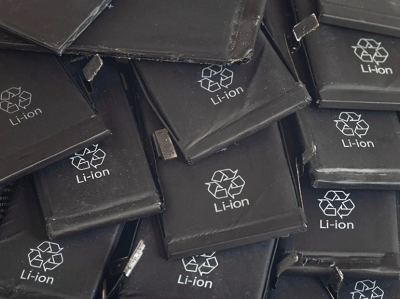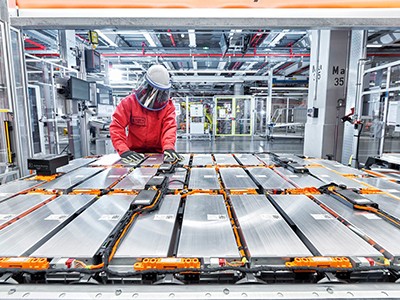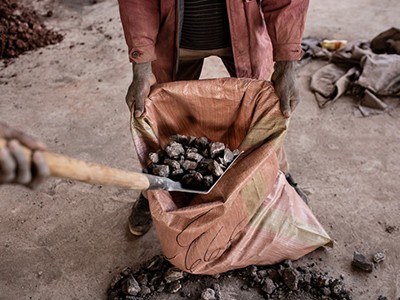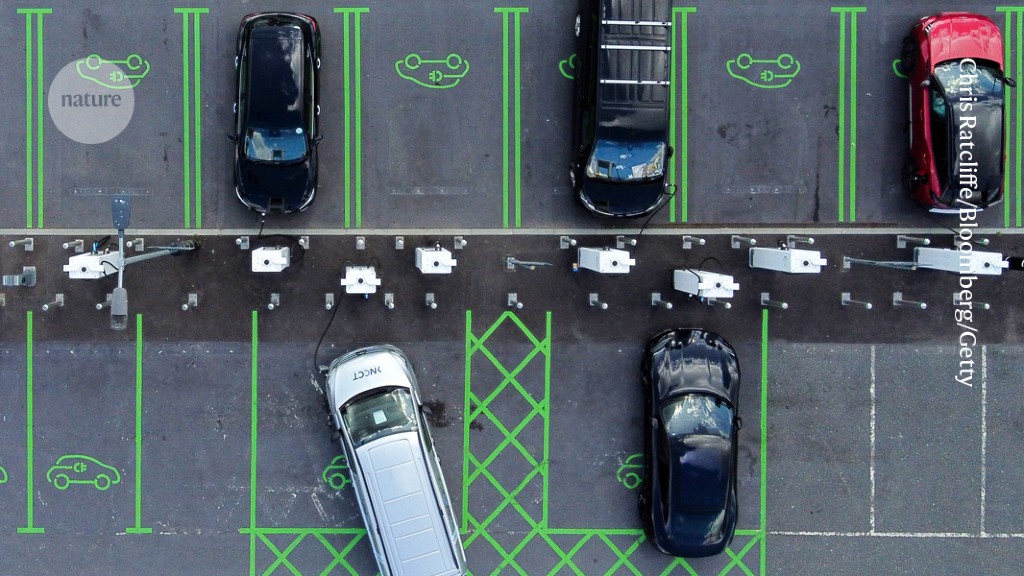
There’s a revolution brewing in batteries for electrical vehicles. Japanese automotive maker Toyota mentioned final yr that it goals to launch a automotive in 2027–28 that would journey 1,000 kilometres and recharge in simply 10 minutes, utilizing a battery kind that swaps liquid elements for solids. Chinese language producers have introduced price range vehicles for 2024 that includes batteries based mostly not on the lithium that powers at present’s finest electrical autos (EVs), however on low-cost sodium — one of the ample parts in Earth’s crust. And a US laboratory has shocked the world with a dream cell that runs partly on air1 and will pack sufficient power to energy aeroplanes.
These and different bulletins depend on various designs to the traditional lithium-ion batteries which have dominated EVs for many years. Though lithium-ion is difficult to beat, researchers assume {that a} vary of choices will quickly fill totally different niches of the market: some very low-cost, others offering way more energy. “We’re going to see the market diversify,” says Gerbrand Ceder, a supplies scientist on the College of California, Berkeley.
The pursuit of higher automotive batteries is fierce, largely as a result of the market is skyrocketing. Greater than a dozen nations have declared that every one new vehicles should be electrical by 2035 or earlier. The Worldwide Vitality Company forecasts that the worldwide inventory of EVs on the highway will rise from 16.5 million in 2021 to just about 350 million by 2030 (see go.nature.com/42mpkqy), and that demand for power from EV batteries will attain 14 terawatt hours (TWh) by 2050, which is 90 occasions greater than in 20202.
Automobile batteries have a stiff checklist of necessities. They should pack a variety of power into as little materials and weight as attainable in order that vehicles can go farther on a single cost. They should present sufficient energy for acceleration, recharge quick, have an extended lifespan (the widespread normal is to resist 1,000 full recharging cycles, which ought to final a shopper 10–20 years), work effectively throughout huge temperature ranges and be protected and reasonably priced. “It’s very arduous to optimize all this stuff without delay,” says Linda Nazar, a battery researcher on the College of Waterloo, Canada.
So researchers are pursuing a plethora of choices, with totally different targets in thoughts. The US Division of Vitality’s (DoE’s) Battery500 programme, launched in 2017, is aiming for a cell power density of 500 watt-hours per kilogram (Wh kg–1), a 65% increase in contrast with at present’s finest merchandise. The PROPEL-1K programme, launched final yr by the US Superior Analysis Initiatives Company–Vitality, is ambitiously aiming for a longer-term purpose of 1,000 Wh kg–1. As for value, the DoE’s Automobile Applied sciences Workplace is aiming to hit US$60 per kilowatt hour by 2030, about half at present’s costs, which it reckons will imply that the worth of electrical vehicles will break even with the price of these powered by gasoline guzzling petrol engines (see ‘Powering up’).
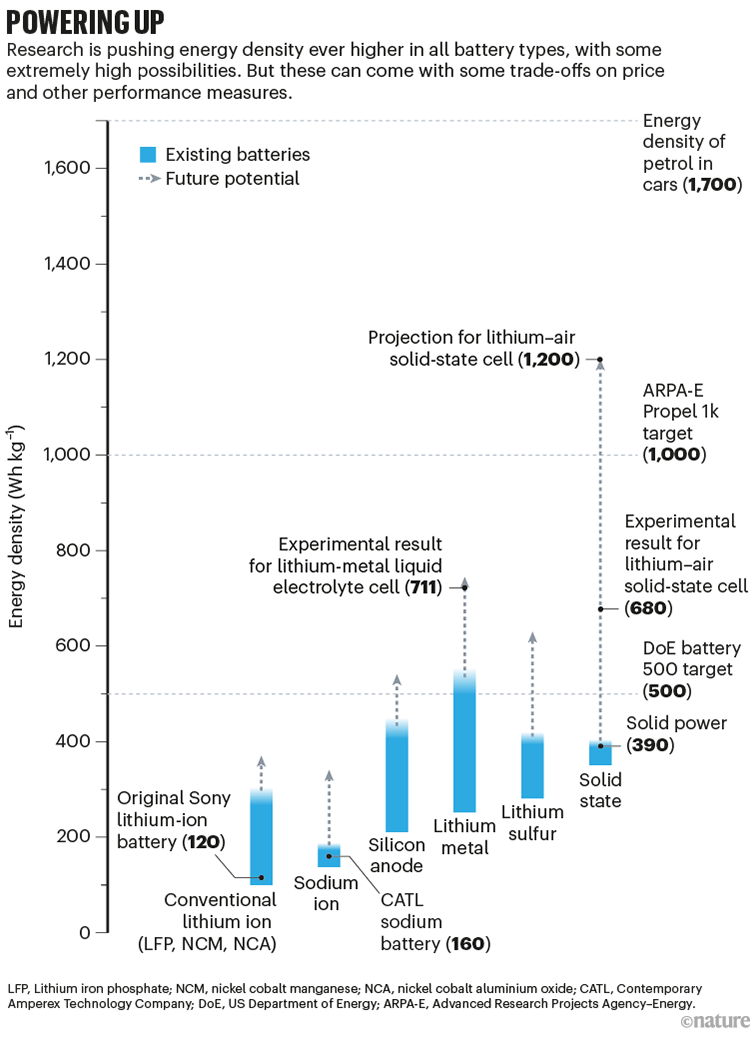
Supply: Ref. 3
It’s arduous to pin down the place issues stand. Industrial bulletins about yet-to-be-released batteries or vehicles typically emphasize one metric over others, and proprietary claims might be not possible to examine till batteries have been examined for years in real-world vehicles. Nevertheless it’s clear that many years of labor on variants similar to solid-state and sodium batteries are lastly coming to fruition, says Nazar. As for the far future, loads of battery chemistries stay tantalizing prospects. “Now everybody has accepted battery improvement is basically essential, everyone seems to be tripping over themselves to do it,” she says.
Electrode evolution
Batteries are successfully chemical sandwiches, which work by shuttling charged ions from one aspect (the anode) to the opposite (the cathode) by way of some intermediate materials (the electrolyte) whereas electrons circulate in an outdoor circuit. Recharging the battery means shunting the ions again to the anode (see ‘How a battery works’).
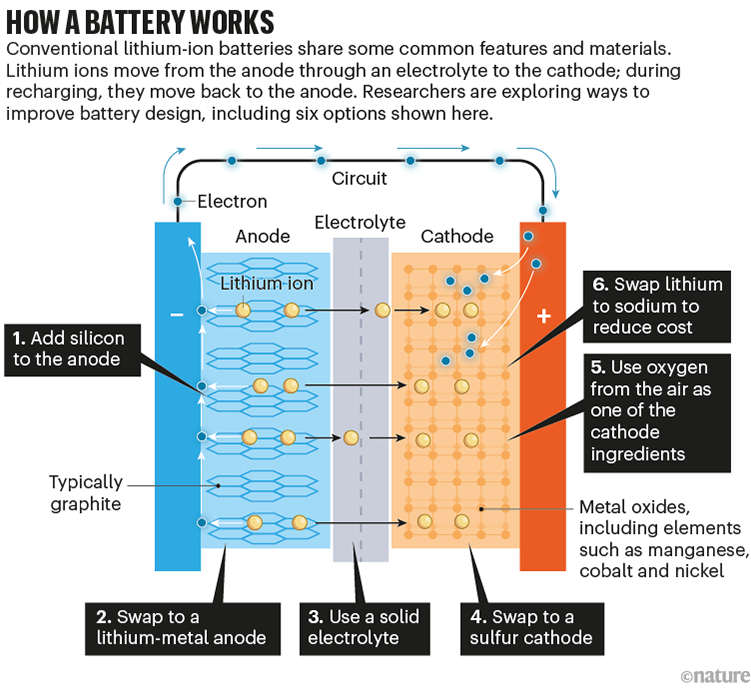
Supply: Tailored from G. Harper et al. Nature 575, 75–86 (2019) and G. Provide et al. Nature 582, 485–487 (2020)
At present, most electrical vehicles run on some variant of a lithium-ion battery. Lithium is the third-lightest ingredient within the periodic desk and has a reactive outer electron, making its ions nice power carriers. The lithium ions journey between an anode normally constituted of graphite and a cathode constituted of a metallic oxide, each of which host lithium ions between atomic layers. The electrolyte is usually an natural liquid.
Lithium-ion batteries have improved loads because the first industrial product in 1991: cell power densities have almost tripled, whereas costs have dropped by an order of magnitude3. “Lithium-ion is a formidable competitor,” says Ceder. And with additional scope for enchancment, some say lithium-ion shall be king for a very long time. “I believe lithium ion will for many years be the expertise which powers electrical vehicles, as a result of it’s ok,” says Winfried Wilcke, a not too long ago retired scientist in Los Altos, California, who headed an IBM Analysis battery challenge from 2009 to 2015.
Many of the enchancment in lithium-ion up to now has come from modifications to the fabric of the cathode, leading to a number of industrial cell sorts. One, fashionable in laptops, makes use of lithium cobalt oxide, which produces comparatively mild however costly batteries. Others, fashionable in lots of vehicles, use a mixture of nickel and cobalt with aluminium or manganese as a stabilizer (NCA and NCM). Then there’s lithium iron phosphate (LFP), which does with out costly cobalt and nickel however to this point has comparatively poor power densities (see ‘Lithium-ion battery sorts’). LFP’s worth has made it enticing and loads of researchers and firms are working to enhance it; US EV producer Tesla notably determined in 2021 to swap to LFP batteries in its mid-range vehicles.
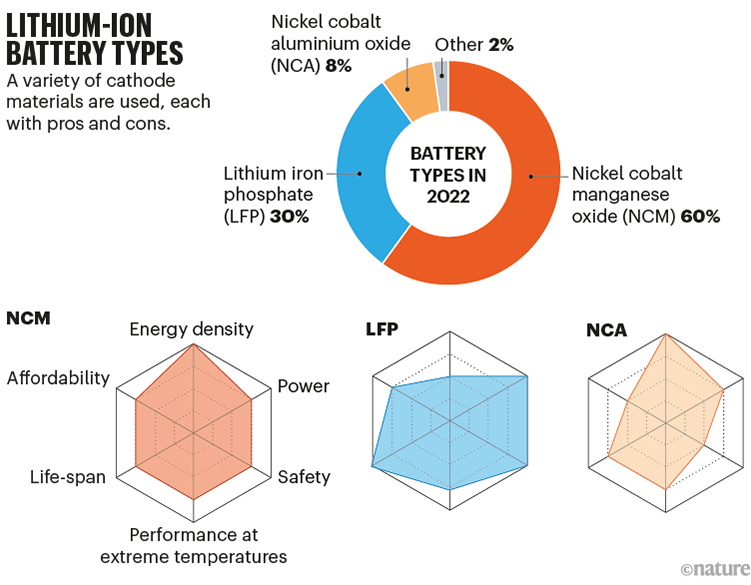
Sources: IEA and Y. Miao et al. Energies 12, 1074 (2019)
There may be scope for extra tweaks to the cathode. In NCM batteries, researchers have been paring again more-expensive cobalt in favour of nickel, which additionally supplies the next power density. That path has led to industrial NCM811 battery cathodes with 80% nickel, and researchers are actually engaged on NCM955, with 90% nickel.
In the meantime, on the anode, one widespread choice is to swap graphite for silicon, a cloth that may retailer ten occasions extra lithium atoms per weight. The problem is that silicon expands and contracts by round 300% throughout cost–discharge cycles, placing a variety of structural pressure on the battery and limiting its lifetime.
Even higher than a silicon anode is solely lithium itself. “You don’t have any wasted materials,” says chemical engineer Brian Cunningham on the DoE’s Automobile Applied sciences Workplace in Arlington, Virginia. Along with chopping down on weight, this may velocity up charging, as a result of there isn’t a ready for lithium ions to fit in between any layers (this modification, technically, makes the design a lithium-metal slightly than a lithium-ion battery). However an enormous downside with this technique is that in recharging, lithium tends to redeposit on the anode erratically, with hotspots that kind tendrils referred to as dendrites, which might attain out by way of the electrolyte and short-circuit the battery.
Lithium-based batteries with higher electrodes can, in idea, obtain large power densities, however usually have trade-offs by way of cell lifetimes or security. Final yr, one group of researchers in China reported a cell with a lithium-metal anode (and a sort of lithium-rich cathode) that hit larger than 700 Wh kg–1 within the lab4. The group’s start-up agency, WeLion New Vitality in Beijing, is aiming to develop and commercialize this battery, together with different choices. One other aspirational concept providing excessive power densities is a lithium sulfur (LiS) battery, with a lithium-metal anode and a sulfur cathode. However sulfur reacts with lithium to make soluble merchandise that may deposit on the anode and kill the battery. LiS “has been tried for 30 years and it nonetheless has main challenges”, says Ceder.
With such troubles plaguing batteries with higher electrodes, many say essentially the most attractive answer is to exchange the liquid electrolyte with a stable.
Strong concept
The thought of solid-state batteries is to make use of a ceramic or stable polymer because the electrolyte, which hosts the passage of lithium ions however helps to stem dendrite formation. Not solely does this make it simpler to make use of an all-lithium anode — with the attendant energy-density benefit — however eliminating the flammable natural liquid additionally means eradicating a hazard that may trigger fires. The cell structure of solid-state batteries is easier than that of liquid-based cells, says Nazar. And the stable batteries, in idea, work higher each at low temperatures (as a result of there’s no liquid to get extra viscous when it’s chilly) and at excessive temperatures (as a result of the interfaces with the electrodes don’t endure a lot when it’s scorching).
Might grinding up lithium batteries assist to recycle them?
However there are challenges: specifically, learn how to manufacture a clean, flawless interface between the layers. Additionally, the transport of ions by way of a stable tends to be slower than by way of a liquid, limiting energy. And solid-state batteries require a wholly new manufacturing course of. “From all we see, they are going to be costlier,” says Ceder.
“Strong state has an enormous future. No query. Nevertheless it’s bloody tough to make it occur,” says Wilcke.
Some battery corporations are transferring ahead with stable state. Colorado-based Strong Energy in Louisville (partnered with automotive makers BMW and Ford), for instance, has begun pilot-scale manufacturing of a solid-state cell with a silicon-based anode that they are saying hits 390 Wh kg–1, and California-based QuantumScape (which has signed offers with producers together with Volkswagen) has a solid-state battery that will get some great benefits of a lithium anode with a good lower-weight, anode-less design. Lithium metallic gathers on the anode aspect, however there isn’t a want for a lithium plate there to begin with. A few of these battery particulars are proprietary. QuantumScape has launched some prototype efficiency information, however gained’t say what its electrolyte is constituted of or what the power density is of its supposed first industrial product. Typically, the touted larger power densities for solid-state batteries are “unproven at present at any form of industrial scale”, says Ceder.
Precise vehicles powered by solid-state batteries appear to be perpetually on the horizon: Toyota’s authentic goal date for commercializing them within the early 2020s has now slipped to the late 2020s, for instance. In terms of batteries, “Toyota has mentioned a variety of issues within the final ten years, none of which have come by way of,” cautions Ceder. However Nazar thinks the timeframe usually is practical. “I imagine that in 2025, we’re most likely going to see some market intrusion of a few of these cells,” she says, particularly provided that there are some formidable Chinese language corporations on the case. That features the world’s largest battery producer, Modern Amperex Expertise (CATL), headquartered in Ningde.
In the meantime, loads of researchers are pursuing methods to enhance stable state. Chemist Jennifer Rupp on the Technical College of Munich in Germany has based an organization, QKera, additionally in Munich, that manufactures ceramic electrolytes at half the same old 1,000 °C temperature. That each helps to restrict carbon dioxide emissions from the furnaces used within the manufacturing course of and helps to resolve some points over binding the electrolyte to the cathode. One other promising angle, says Nazar, is a brand new class of oxyhalide electrolytes for solid-state batteries. A few of these are ‘gooey’ and so extra versatile, which ought to ease manufacturing and make them much less weak to cracking5. And a few have extraordinarily excessive conductivity, letting lithium ions zoom by way of as if by way of a liquid slightly than a stable, with related energy advantages6. Different companies are engaged on a solid-state model of LiS, says Cunningham.
The ‘pot of gold’ battery on the finish of this solid-state rainbow, many say, could be a lithium–air design. This sort of battery makes use of a lithium-metal anode, and the cathode is predicated on lithium binding to oxygen that’s pulled from the air and launched once more when the battery recharges. Partly as a result of a key cathode ingredient isn’t saved within the battery, this design can maintain way more power per kilogram. However the concept has lengthy appeared speculative. “A few of my colleagues name it fairy-tale chemistry,” says Nazar.
Supplies scientist Larry Curtiss at Argonne Nationwide Laboratory in Lemont, Illinois, and his colleagues hit the headlines in 2023 with a stunning paper displaying a solid-state, experimental lithium–air battery examined over 1,000 cycles within the lab1. The crew says its coin-sized take a look at cell runs at about 685 Wh kg–1 and will have the ability to attain 1,200 Wh kg–1, 4 occasions what’s achievable with lithium-ion now and roughly comparable with the power density of petrol in vehicles. The experimental system works utilizing a brand new chemistry that shocked even the crew learning it. Earlier lithium–air battery initiatives, sometimes utilizing liquid electrolytes, made lithium superoxide (LiO2) or lithium peroxide (Li2O2) on the cathode, which retailer one or two electrons per oxygen molecule. The brand new cell as an alternative makes lithium oxide (Li2O), which might maintain 4. These additional electrons translate to the next power density, and the system appears much more secure than earlier efforts, which ought to result in longer battery life.
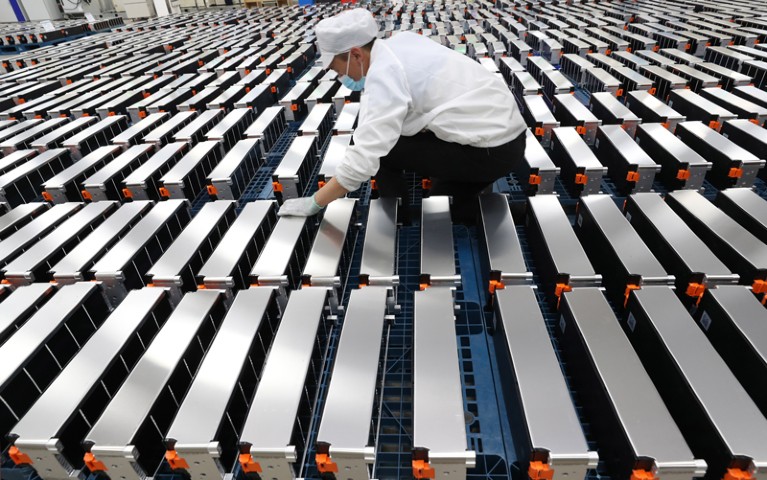
An worker works on an electric-vehicle battery system at a workshop in Nanjing, China.Credit score: Xu Congjun/VCG/Getty
“It’s unbelievable what they did,” says Wilcke. “They will use strange soiled air with moisture and carbon dioxide and all the opposite crap that you just discover in unfiltered air. Not an issue,” says Wilcke. However many say they want to see the trouble replicated earlier than getting too excited. And though it’s an amazing power storage system, it’s unclear how it will work in apply — how you would get the air out and in, for instance, and whether or not it may be constructed larger and made to work with larger currents. “It’s undoubtedly a for much longer time horizon then than even lithium sulfur,” says Cunningham.
Curtiss says the crew is considering aviation as the perfect utility for the expertise, provided that it’s so power dense. Wilcke agrees. Vitality density is a “large, large think about plane”, says Wilcke, who’s bullish specifically on electrical vertical take-off and touchdown craft, anticipated for use as ‘flying taxis’. If that seems like science fiction, an electrical air taxi was licensed to fly in China — even with out a pilot — in October 2023, and a number of other corporations make craft that may go a few hundred kilometres on lithium-ion batteries. Air taxis that may skip the site visitors taking you from the airport to your resort, Wilcke says, are an emergent business that’s about to take off.
Value drop
As the hunt continues for miracle batteries that pack in ever extra power, some scientists argue that essentially the most urgent concern is the necessity to decide a battery chemistry that shall be low-cost and sustainable in the long term.
“The largest challenges are resource-related,” says Ceder, who calculates that the projected 14 TWh wanted for vehicles by 2050 would require 14 million tonnes of complete metallic. That’s loads; for comparability, at present’s international mining of lithium is about 130,000 tonnes per yr, whereas cobalt is almost 200,000 tonnes and nickel 3.3 million tonnes — that’s for all functions, together with non-EV batteries and, for nickel, stainless-steel. The amount wanted makes it essential to decide on metals that aren’t scarce or costly and don’t trigger extreme environmental harm when they’re mined.
Electrical vehicles and batteries: how will the world produce sufficient?
Loads of researchers and firms are attempting to make batteries that don’t use nickel, cobalt or different costly metals. QuantumScape, for instance, says its batteries have this benefit, as do lithium–air ideas, LiS (if it may be made to work), different experimental supplies7 and the already industrial LFP cathodes (though LFP may put a pressure on phosphorus sources if that expertise scales up loads). Ceder is various cathodes referred to as disordered rocksalts (DRX)8. These depend on the concept that lithium ions can simply meander by way of a crystalline cathode slightly than taking an ordered path by way of layers, and thus the cathode might be made with nearly any transition metals. Ceder’s crew favours manganese and titanium. He expects the primary batteries with DRX cathodes to be cheaper than present lithium-ion cells and to attain comparable power densities.
Maybe the final word purpose is to eliminate the lithium itself — a metallic that has seen wild worth swings because of booming demand and provide pinchpoints. In 2022–23, for instance, battery-grade lithium carbonate costs briefly spiked at six occasions larger than normal.
Researchers have toyed with changing lithium with loads of different cost carriers, together with magnesium, calcium, aluminium and zinc, however work on sodium is essentially the most superior. Sodium lies straight beneath lithium within the periodic desk, making its atoms heavier and greater, however with comparable chemical properties. This implies a variety of the teachings from lithium battery improvement and manufacturing might be copied over to sodium. And sodium is way simpler to supply: it’s about 1,000 occasions extra plentiful in Earth’s crust than is lithium. “Sodium is simply unbelievably ample,” says Ceder, who thinks sodium batteries might find yourself costing round $50 per kilowatt hour.
Sodium batteries are already in manufacturing (see go.nature.com/3tnwdgt). Chinese language conglomerate BYD — which in early 2024 changed Tesla because the world’s largest EV producer — has damaged floor on its first sodium-ion battery plant. And Chinese language automotive makers Chery, JMEV and JAC have all introduced price range vehicles powered by sodium-ion batteries of their line-up for China this yr. Listing costs for these small vehicles are anticipated to be round $10,000.
On the plus aspect, sodium’s bigger atomic dimension opens up extra choices for the metals that can be utilized within the layered metallic oxides on the cathode, says Ceder: “There’s much more chemical flexibility.” And researchers might make an anode-less solid-state battery with sodium, too — an attractive risk, says Nazar.
Lithium-ion batteries should be greener and extra moral
However the heavier weight of sodium in comparison with lithium makes it basically more durable to get to excessive power densities. There additionally hasn’t been as a lot time to develop the perfect electrodes and electrolytes — sodium-ion battery power density now roughly matches that of the perfect lithium-ion batteries from a decade in the past. CATL has a sodium battery that hit an marketed power density of 160 Wh kg–1 in 2021 at a reported worth of $77 per kilowatt hour; the corporate says that may ramp as much as 200 Wh kg–1 in its subsequent mannequin. These decrease power densities imply that vary is proscribed.The ultra-compact vehicles anticipated to run on sodium batteries have marketed ranges of round 250–300 km, in contrast with almost 600 km for a lithium-powered Tesla Mannequin S.
“It’s going to want chemistry advances with a view to get to the extent that’s crucial for the automotive market in the US,” says Cunningham, the place customers are used to longer drives and greater vehicles.
Some corporations, together with UK-based Faradion and Swedish Northvolt, are selling their sodium batteries (additionally each marketed at 160 Wh kg–1) to retailer extra renewable power for electrical energy grids, the place sodium’s weight downside is much less of a problem.
Guess and take a look at
Battery improvement is onerous, as a result of the behaviours of supplies will not be at all times predictable. Rupp says, as an example, that it at present takes researchers 8–15 years to give you new solid-state electrolyte designs and optimize the specs, together with which components to make use of and learn how to pack in excessive densities of lithium. “This offers me as a cloth scientist two-and-a-half extra supplies to work on” earlier than retirement, says Rupp. “That’s too sluggish”.
Help is coming from synthetic intelligence (AI) and automated synthesis, which may also help to discover extra choices extra rapidly. For instance, the DoE’s Pacific Northwest Nationwide Laboratory in Richland, Washington, is working with Microsoft to quickly give you new battery supplies; a lithium–sodium stable electrolyte discovered this manner is now in preliminary exams.
However these AI methods are restricted by the knowledge that chemists should feed into them, says Nazar. There are nonetheless loads of unknowns, she says, about what’s truly happening on the atomic stage on the interface of electrode and electrolyte supplies.
Ultimately, consultants say we’re more likely to see a variety of batteries for our future vehicles — in a lot the identical means that we have now 2-, 4- and 6-cylinder engines at present. We would see sodium batteries or LFP for lower-range vehicles, forklifts or specialist autos, for instance. Then there is perhaps improved lithium-ion batteries, possibly utilizing silicon anodes or rocksalt cathodes, for mid-range autos, or maybe solid-state lithium batteries will take over that class. Then there is perhaps LiS and even lithium–air cells for high-end vehicles — or flying taxis. However there’s a variety of work but to be carried out. “The entire totally different chemistries that aren’t commercialized at present have their execs and cons,” says Cunningham. “Our job is to take away all these cons.”
